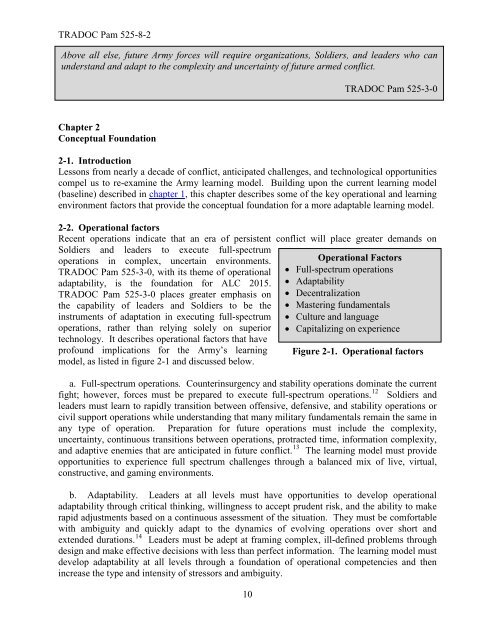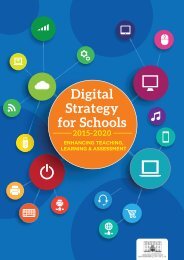K3zgZ
K3zgZ
K3zgZ
You also want an ePaper? Increase the reach of your titles
YUMPU automatically turns print PDFs into web optimized ePapers that Google loves.
TRADOC Pam 525-8-2<br />
Above all else, future Army forces will require organizations, Soldiers, and leaders who can<br />
understand and adapt to the complexity and uncertainty of future armed conflict.<br />
TRADOC Pam 525-3-0<br />
Chapter 2<br />
Conceptual Foundation<br />
2-1. Introduction<br />
Lessons from nearly a decade of conflict, anticipated challenges, and technological opportunities<br />
compel us to re-examine the Army learning model. Building upon the current learning model<br />
(baseline) described in chapter 1, this chapter describes some of the key operational and learning<br />
environment factors that provide the conceptual foundation for a more adaptable learning model.<br />
2-2. Operational factors<br />
Recent operations indicate that an era of persistent conflict will place greater demands on<br />
Soldiers and leaders to execute full-spectrum<br />
operations in complex, uncertain environments.<br />
TRADOC Pam 525-3-0, with its theme of operational<br />
adaptability, is the foundation for ALC 2015.<br />
TRADOC Pam 525-3-0 places greater emphasis on<br />
the capability of leaders and Soldiers to be the<br />
instruments of adaptation in executing full-spectrum<br />
operations, rather than relying solely on superior<br />
technology. It describes operational factors that have<br />
profound implications for the Army’s learning<br />
model, as listed in figure 2-1 and discussed below.<br />
a. Full-spectrum operations. Counterinsurgency and stability operations dominate the current<br />
fight; however, forces must be prepared to execute full-spectrum operations. 12 Soldiers and<br />
leaders must learn to rapidly transition between offensive, defensive, and stability operations or<br />
civil support operations while understanding that many military fundamentals remain the same in<br />
any type of operation. Preparation for future operations must include the complexity,<br />
uncertainty, continuous transitions between operations, protracted time, information complexity,<br />
and adaptive enemies that are anticipated in future conflict. 13 The learning model must provide<br />
opportunities to experience full spectrum challenges through a balanced mix of live, virtual,<br />
constructive, and gaming environments.<br />
b. Adaptability. Leaders at all levels must have opportunities to develop operational<br />
adaptability through critical thinking, willingness to accept prudent risk, and the ability to make<br />
rapid adjustments based on a continuous assessment of the situation. They must be comfortable<br />
with ambiguity and quickly adapt to the dynamics of evolving operations over short and<br />
extended durations. 14 Leaders must be adept at framing complex, ill-defined problems through<br />
design and make effective decisions with less than perfect information. The learning model must<br />
develop adaptability at all levels through a foundation of operational competencies and then<br />
increase the type and intensity of stressors and ambiguity.<br />
10<br />
Operational Factors<br />
• Full-spectrum operations<br />
• Adaptability<br />
• Decentralization<br />
• Mastering fundamentals<br />
• Culture and language<br />
• Capitalizing on experience<br />
Figure 2-1. Operational factors




